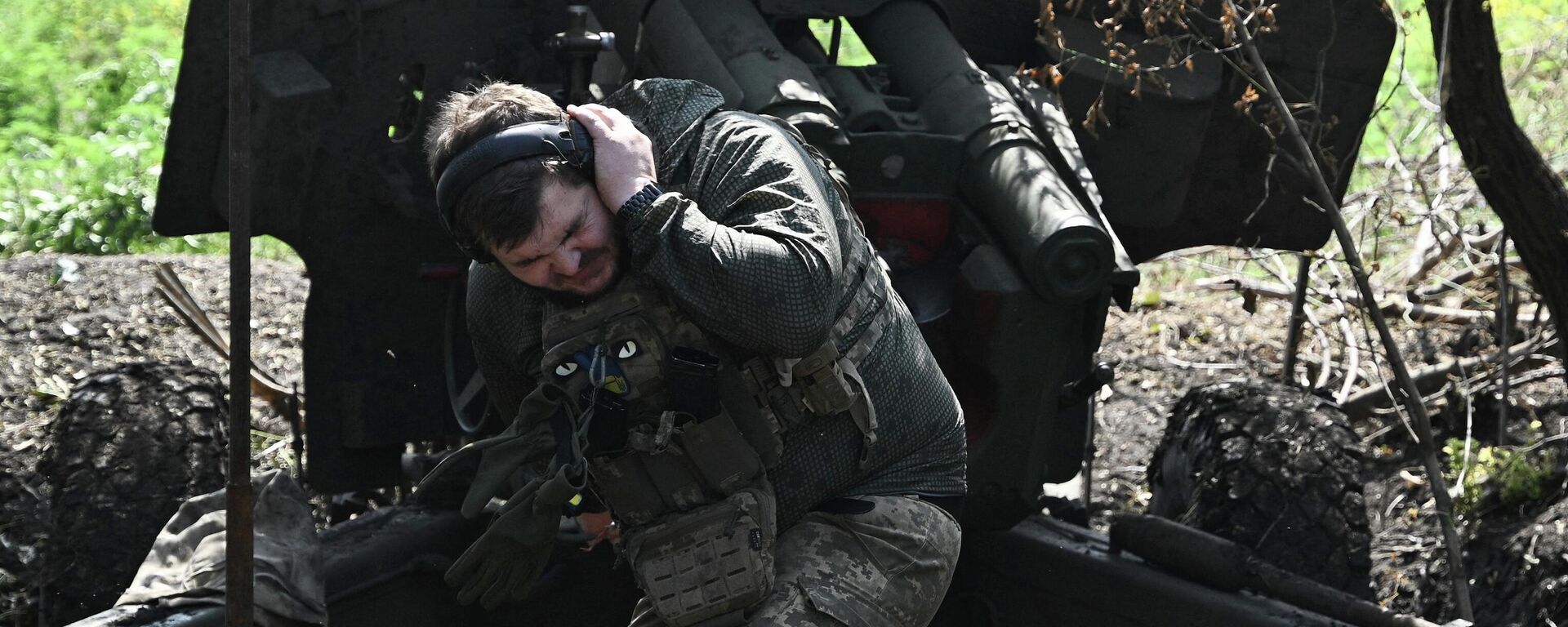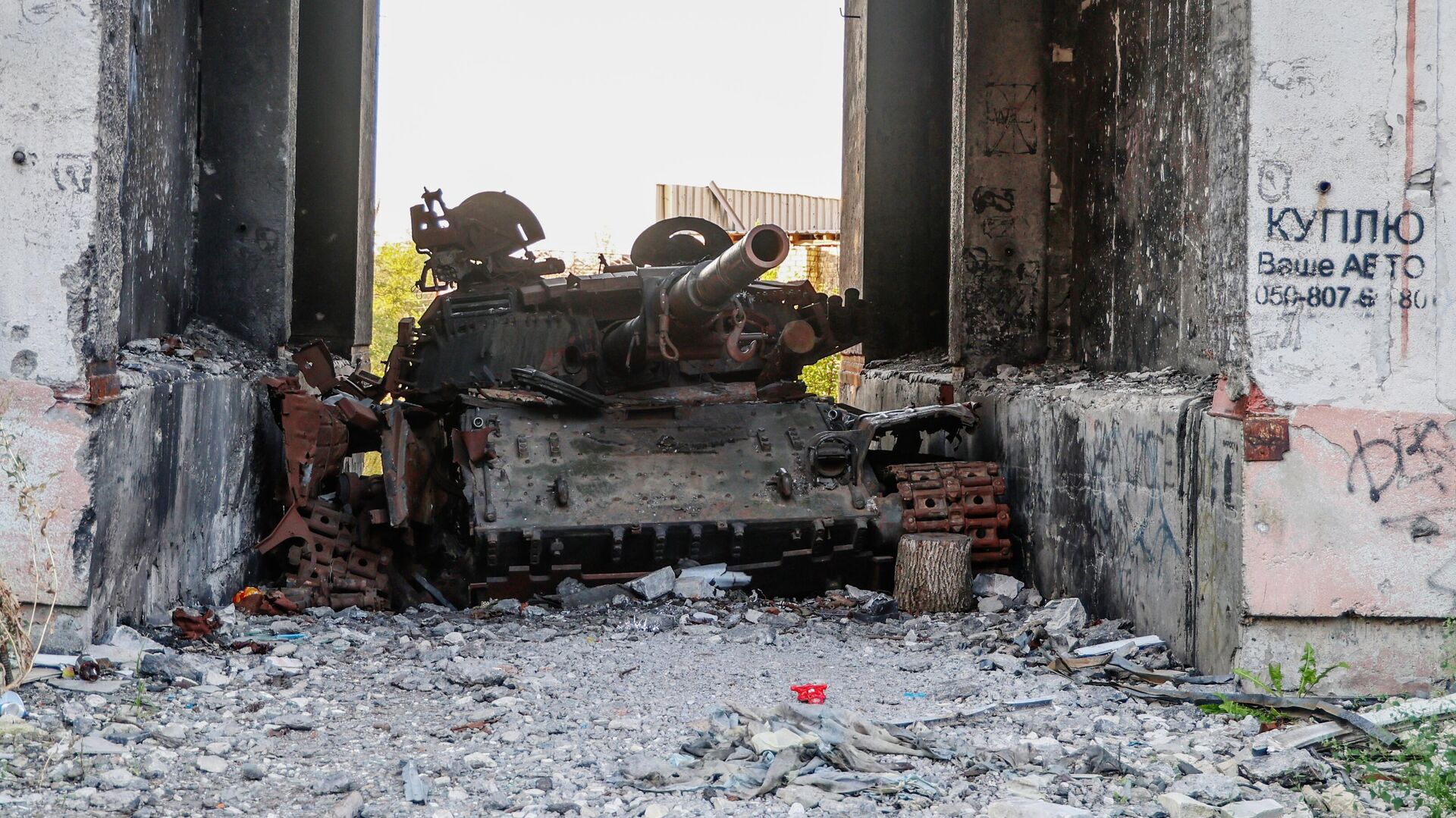https://sputnikglobe.com/20230830/scott-ritter-ukraines-fate-sealed-long-before-failing-counteroffensive-1112990937.html
Scott Ritter: Ukraine’s Fate Sealed Long Before Failing Counteroffensive
Scott Ritter: Ukraine’s Fate Sealed Long Before Failing Counteroffensive
Sputnik International
Recently the armed forces of Ukraine have come under criticism from their Western military partners for carrying out operations in support of the ongoing counteroffensive in a manner which deviates from the operational theory of combined arms warfare.
2023-08-30T13:17+0000
2023-08-30T13:17+0000
2023-08-31T08:29+0000
russia's special operation in ukraine
ukrainian crisis
ukrainian counteroffensive attempt
ukrainian ultra-nationalists
us arms for ukraine
https://cdn1.img.sputnikglobe.com/img/07e7/08/1f/1113011674_0:113:3241:1936_1920x0_80_0_0_a4180240d3f4629bfef3768d1fcd90a7.jpg
Combined arms warfare integrates the capabilities inherent in separate combat arms (infantry, artillery, armor, air, electronic warfare, etc.) into a singular effort that complements one another, thereby increasing the lethality and efficiency of operations. The theory of combined arms warfare that served as the foundation for the training of Ukrainian forces by NATO in the lead up to the current counteroffensive is founded in present day US and NATO doctrine which emphasizes fundamental principles and tactics, techniques, and procedures which, when properly implemented, are designed to achieve the desired result.According to the media statements attributed to US and NATO military officers who had been involved in the training of Ukrainian forces, the Ukrainian army has failed to implement the tactics they had been instructed on, which emphasized a combined arms approach that used firepower to suppress Russian defenses while armored units advanced aggressively, seeking to combine shock and mass to break through prepared defensive positions. According to these western officers, the Ukrainians have proven “casualty averse”, allowing the loss of manpower and equipment in the face of Russian resistance to break up their attacks, dooming the counteroffensive to failure.The Ukrainians, on the other hand, contend that the combined arms training they received was based upon doctrinal principals, such as the necessity of adequate air support, which Ukraine was never able to implement, dooming the counteroffensive to failure from the start, and forcing Ukraine to adapt to the realities of the battlefield by ditching the combined arms approach in favor of an infantry-focused battle. The fact that these new tactics have produced a prodigious number of Ukrainian casualties contradicts the notion that Ukraine is casualty averse.The tragic reality is that neither approach to warfare has enabled Ukraine to achieve the ambitious goals and objectives it has set out for itself when launching the counteroffensive, namely the breaching of the Russian defenses leading to the severing of the land bridge connecting Crimea to Russia. While Ukraine, with the support of its NATO allies, has accrued sufficient military capacity to engage in concerted military operations against Russia since the counteroffensive began in early June, the reality is that this effort is unsustainable. In short, Ukraine has reached the end of its tether. While the tactical situation along the line of contact with Russia fluctuates daily, and Ukraine has been able to achieve some limited success in certain areas, the cost that comes with these successes has been so high that Ukraine lacks not only the ability to exploit these successes, but is in danger of not being able to maintain a military presence along the entirety of the frontline sufficient to hold back any concerted Russian offensive operations.The heavy casualties suffered by Ukraine, combined with the failure of the counteroffensive to breach even the first line of the prepared Russian defenses, have prompted the Ukrainian army to commit its strategic reserve into the fight. This reserve, consisting of some of the best trained and equipped forces available to the Ukrainians, was meant to exploit the advances made by the initial offensive operations. The fact that the strategic reserve has been committed to achieve objectives that all preceding attacking units had failed to accomplish only underscores the futility of the Ukrainian effort, and the inevitability of its ultimate defeat.The collapse of Ukrainian military cohesion along the line of contact with Russia is occurring even as the last vestige of the Ukrainian counteroffensive bleeds itself white in the fields of Zaporozhye. Because of battlefield losses suffered by Ukraine in the months leading up to the initiation of the June counteroffensive (mainly, but not exclusively, in the Battle for Artemovsk), Ukrainian forces were stretched thin as units were reshuffled along the front to replace those that had been depleted in battle. As the counteroffensive floundered, military resources were withdrawn from other sectors of the front to make up for the losses.This thinning of the Ukrainian lines provided opportunities for the Russian forces, leading to major advances in the vicinity of Kupyansk. As Ukrainian losses continue, this thinning will only become more prevalent, creating gaps in the Ukrainian defenses which can be exploited by a Russian military which has upwards of 200,000 well-trained, well-equipped reserves which have yet to be committed into the battle. This cause-effect relationship will continue, since Ukraine has no more reserves available to replace battlefield losses which will continue to accrue all along the line of contact. Eventually, the Ukrainian posture will be unsustainable, and the Ukrainian high command will be confronted with the reality that they will need to order a general retreat to more defensive positions—perhaps as far back as the right bank of the Dnepr River—or face the inevitability of the total destruction of their army.Ukraine’s fate was sealed long before its counteroffensive was ground down by Russia’s defenses. The roots of Ukraine’s military debacle can be found on the NATO training grounds where Ukrainian soldiers were misled into believing that the training they were receiving would give them NATO-like capability on the battlefield. But the lexicon of combined arms warfare, unless attached to doctrinally-sound principles, tactics, techniques, and procedures, is just a collection of words devoid of meaning and substance.The fundamental idea behind combined arms warfare is that one can demand more of each individual combat arm because the inherent weaknesses present are shielded by the complementary capabilities of the others which, when acting in concert, serve as an overall force multiplier, where the collective is greater than the sum of all the individual components. However, if the shield is missing due to inadequate application of doctrinal fundamentals (such as proceeding void of any air cover), then the effect is simply the same as feeding raw meat into a meatgrinder. NATO knew prior to the Ukrainian counteroffensive that the training was inadequate to the task, and yet the training officers not only remained silent as the Ukrainians they instructed were led down the path of their inevitable demise, but rubbed salt into the Ukrainian wounds by claiming that the fault was on the part of the student, not the teacher.As the Special Military Operation reaches its terminal phase, marked by the collapse of cohesion on the part of a Ukrainian military depleted in battle and unable to adequately reinforce itself, one must reflect on how the situation had deteriorated to this point for a nation, Ukraine, which had been the benefactory of billions of dollars of assistance. While the determination and skill of the Russian military played a major part in shaping the present events on the battlefield, the fact that the Ukrainians were thrown into a battle they were neither organized or trained to wage played a huge role in the scope and scale of the meatgrinder that consumed them.And for this Ukraine can blame—and Russia thank—NATO.
https://sputnikglobe.com/20230826/flagging-ukraine-counteroffensive-triggers-allies-fears-about-support-nosediving---report-1112903607.html
https://sputnikglobe.com/20230823/zelensky-says-counteroffensive-very-hard-for-ukrainian-forces-1112820283.html
Sputnik International
feedback@sputniknews.com
+74956456601
MIA „Rosiya Segodnya“
2023
Scott Ritter
https://cdn1.img.sputnikglobe.com/img/07e6/0c/17/1105733958_0:0:334:334_100x100_80_0_0_b457e4e9c850ef224b0cc79059bb38df.jpg
Scott Ritter
https://cdn1.img.sputnikglobe.com/img/07e6/0c/17/1105733958_0:0:334:334_100x100_80_0_0_b457e4e9c850ef224b0cc79059bb38df.jpg
News
en_EN
Sputnik International
feedback@sputniknews.com
+74956456601
MIA „Rosiya Segodnya“
Sputnik International
feedback@sputniknews.com
+74956456601
MIA „Rosiya Segodnya“
Scott Ritter
https://cdn1.img.sputnikglobe.com/img/07e6/0c/17/1105733958_0:0:334:334_100x100_80_0_0_b457e4e9c850ef224b0cc79059bb38df.jpg
russia special military operation, ukrainian crisis, ukrainian counteroffensive attempt, failed counteroffensive, ukraine counteroffensive
russia special military operation, ukrainian crisis, ukrainian counteroffensive attempt, failed counteroffensive, ukraine counteroffensive
Scott Ritter: Ukraine’s Fate Sealed Long Before Failing Counteroffensive
13:17 GMT 30.08.2023 (Updated: 08:29 GMT 31.08.2023) Recently the armed forces of Ukraine have come under criticism from their Western military partners for carrying out operations in support of the ongoing counteroffensive in a manner which deviates from the operational theory of combined arms warfare.
Combined arms warfare integrates the capabilities inherent in separate combat arms (infantry, artillery, armor, air, electronic warfare, etc.) into a singular effort that complements one another, thereby increasing the lethality and efficiency of operations. The theory of combined arms warfare that served as the foundation for the training of Ukrainian forces by NATO in the lead up to the current counteroffensive is founded in present day US and NATO doctrine which emphasizes fundamental principles and tactics, techniques, and procedures which, when properly implemented, are designed to achieve the desired result.
According to the media statements attributed to US and NATO military officers who had been involved in the training of Ukrainian forces, the Ukrainian army has failed to implement the tactics they had been instructed on, which emphasized a combined arms approach that used firepower to suppress Russian defenses while armored units advanced aggressively, seeking to combine shock and mass to break through prepared defensive positions. According to these western officers, the Ukrainians have proven “casualty averse”, allowing the loss of manpower and equipment in the face of Russian resistance to break up their attacks, dooming the counteroffensive to failure.
The Ukrainians, on the other hand, contend that the combined arms training they received was based upon doctrinal principals, such as the necessity of adequate air support, which Ukraine was never able to implement, dooming the counteroffensive to failure from the start, and forcing Ukraine to adapt to the realities of the battlefield by ditching the combined arms approach in favor of an infantry-focused battle. The fact that these new tactics have produced a prodigious number of Ukrainian casualties contradicts the notion that Ukraine is casualty averse.
The tragic reality is that neither approach to warfare has enabled Ukraine to achieve the ambitious goals and objectives it has set out for itself when launching the counteroffensive, namely the breaching of the Russian defenses leading to the severing of the land bridge connecting Crimea to Russia. While Ukraine, with the support of its NATO allies, has accrued sufficient military capacity to engage in concerted military operations against Russia since the counteroffensive began in early June, the reality is that this effort is unsustainable. In short, Ukraine has reached the end of its tether. While the tactical situation along the line of contact with Russia fluctuates daily, and Ukraine has been able to achieve some limited success in certain areas, the cost that comes with these successes has been so high that Ukraine lacks not only the ability to exploit these successes, but is in danger of not being able to maintain a military presence along the entirety of the frontline sufficient to hold back any concerted Russian offensive operations.
The heavy casualties suffered by Ukraine, combined with the failure of the counteroffensive to breach even the first line of the prepared Russian defenses, have prompted the Ukrainian army to commit its strategic reserve into the fight. This reserve, consisting of some of the best trained and equipped forces available to the Ukrainians, was meant to exploit the advances made by the initial offensive operations. The fact that the strategic reserve has been committed to achieve objectives that all preceding attacking units had failed to accomplish only underscores the futility of the Ukrainian effort, and the inevitability of its ultimate defeat.

26 August 2023, 07:05 GMT
The collapse of Ukrainian military cohesion along the line of contact with Russia is occurring even as the last vestige of the Ukrainian counteroffensive bleeds itself white in the fields of Zaporozhye. Because of battlefield losses suffered by Ukraine in the months leading up to the initiation of the June counteroffensive (mainly, but not exclusively, in the Battle for Artemovsk), Ukrainian forces were stretched thin as units were reshuffled along the front to replace those that had been depleted in battle. As the counteroffensive floundered, military resources were withdrawn from other sectors of the front to make up for the losses.
This thinning of the Ukrainian lines provided opportunities for the Russian forces, leading to major advances in the vicinity of Kupyansk. As Ukrainian losses continue, this thinning will only become more prevalent, creating gaps in the Ukrainian defenses which can be exploited by a Russian military which has upwards of 200,000 well-trained, well-equipped reserves which have yet to be committed into the battle. This cause-effect relationship will continue, since Ukraine has no more reserves available to replace battlefield losses which will continue to accrue all along the line of contact. Eventually, the Ukrainian posture will be unsustainable, and the Ukrainian high command will be confronted with the reality that they will need to order a general retreat to more defensive positions—perhaps as far back as the right bank of the Dnepr River—or face the inevitability of the total destruction of their army.
Ukraine’s fate was sealed long before its counteroffensive was ground down by Russia’s defenses. The roots of Ukraine’s military debacle can be found on the NATO training grounds where Ukrainian soldiers were misled into believing that the training they were receiving would give them NATO-like capability on the battlefield. But the lexicon of combined arms warfare, unless attached to doctrinally-sound principles, tactics, techniques, and procedures, is just a collection of words devoid of meaning and substance.

23 August 2023, 13:45 GMT
The fundamental idea behind combined arms warfare is that one can demand more of each individual combat arm because the inherent weaknesses present are shielded by the complementary capabilities of the others which, when acting in concert, serve as an overall force multiplier, where the collective is greater than the sum of all the individual components. However, if the shield is missing due to inadequate application of doctrinal fundamentals (such as proceeding void of any air cover), then the effect is simply the same as feeding raw meat into a meatgrinder. NATO knew prior to the Ukrainian counteroffensive that the training was inadequate to the task, and yet the training officers not only remained silent as the Ukrainians they instructed were led down the path of their inevitable demise, but rubbed salt into the Ukrainian wounds by claiming that the fault was on the part of the student, not the teacher.
As the Special Military Operation reaches its terminal phase, marked by the collapse of cohesion on the part of a Ukrainian military depleted in battle and unable to adequately reinforce itself, one must reflect on how the situation had deteriorated to this point for a nation, Ukraine, which had been the benefactory of billions of dollars of assistance. While the determination and skill of the Russian military played a major part in shaping the present events on the battlefield, the fact that the Ukrainians were thrown into a battle they were neither organized or trained to wage played a huge role in the scope and scale of the meatgrinder that consumed them.
And for this Ukraine can blame—and Russia thank—NATO.








